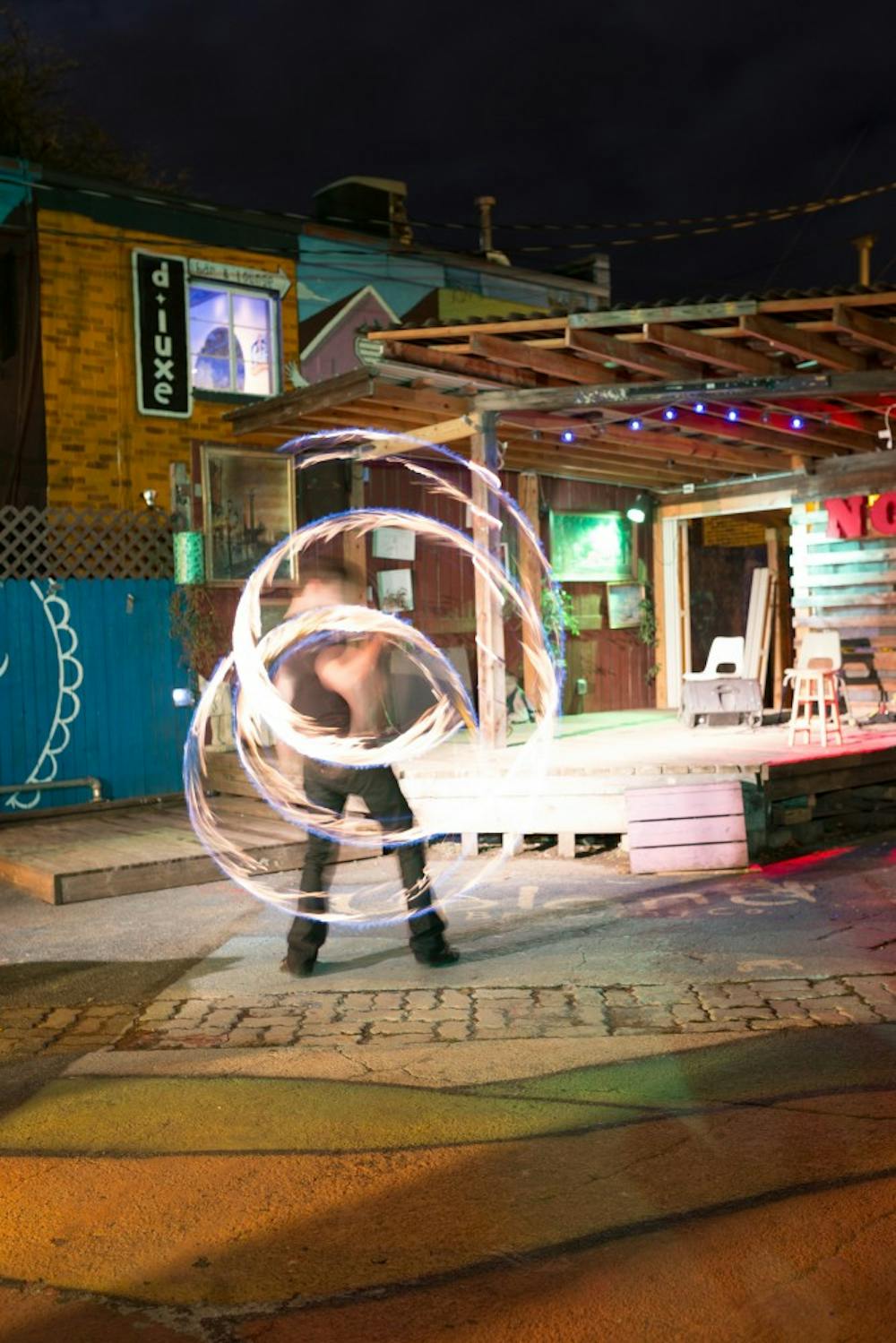Orange light splashed the backyard of Be Here Now. Then the sound came. A roaring whoosh of flame lit up the patio as Jason Riley whipped the burning rod through the air. Burning at both ends, the pole twirled around his body, through his legs and then extinguished with a forceful final swing.
They call it “spinning” or “flow arts.” Descended from the Maori poi tradition, flow arts performers twirl batons, ropes, hoops and other props to create rhythmic visuals and display skill.
“Have you ever seen the cliché fire-spinning people on the Hawaiian beach with the ball on chains?” says Riley. “That’s poi.”
Riley, 24, first became exposed to flow arts in high school and educated himself on the subject. He practiced six months with a dowel rod before he knew enough tricks to transition smoothly between them all.
“I thought it was spectacular,” he says. “It was an exercise I enjoyed. It kind of works out that I can entertain people with it.”
On the sidewalk along North Dill Street, Urayah Arrowwood wrapped colorful LED poi around his arms and back out through the air. Later, he traded the plastic props for flame.
“Teaching is probably one of my top favorite parts about spinning poi,” says Arrowwood, 24. “The investment can be as little as some socks and some tennis balls if you want to find out if you’re into it.”
Matt Dailey got his first taste of flow arts back in 2009 while attending music festivals, but he really got into it around 2011. He also enjoys drumming, which he says is a natural fit with poi spinning.
“Anyone who has a basic understanding of rhythm can enjoy flow art,” he says. “It’s wonderful to do with music, very cohesive.”
A large part of the flow arts experience rests on the concept of “flow.”
Riley described “flow” as a phenomenon where one achieves “energized focus, full involvement and success” while participating in a particular activity. Flow arts are often performed with music, Riley says that because rhythm not only contributes to the show, but also helps the performer achieve “flow.”
“[It’s] a state of mind where you’re entirely focused on this one activity,” he says. “It feels good. Nothing else matters to me at that point.”
Riley has displayed his skills at house parties and bars to promote his art.
He says that flow arts have become more prevalent in recent years. When he first began, he says that about half of the people who saw him really enjoyed the performances, while others weren’t so sure. Party hosts would worry that the fire would draw cops. Others were just concerned about safety.
Riley says he’s been stopped by the police more than once but never had a negative interaction with any of them pertaining to flow arts.
“When the fire is around, you tend to be a little more cautious,” he says. “It’s not all that dangerous, you just have to be prepared.”
Laura Haisley, 25, specializes in hoop spinning, an interest she picked up from a friend. Performing with both LED and flaming hoops, she hones her skills through practice, performance and attending flow festivals.
“There’s a lot more to the festivals than just playing with toys,” she says.
Haisley once took a stage management class at a festival and learned how to plan a fire show, coordinate with vendors and how to work a venue. Training is also often offered in both tricks as well as other skills, like transitions.
“I hear the music, I go with the music, and that’s kind of my moment,” Haisley says. “I’m definitely a happier person.”
Dailey, Haisely, Arrowwood and Riley all participated in what they called Spundae-Monday, a weekly gathering of ten-to-20 flow enthusiasts.
“It started out as something more of a workshop,” Dailey says. “It became ‘Let’s get together and watch each other spin fire.’”
The group no longer meets, but they haven’t stopped spinning. Whether it’s a paid gig, a planned pro bono performance or a simple sidewalk show, the passion is still there.
“I think humans have this natural attraction to fire,” Arrowwood says. “[Poi is] like a lot of other things. Once you get in a zone, or flow, you stay there until you’re done.”





